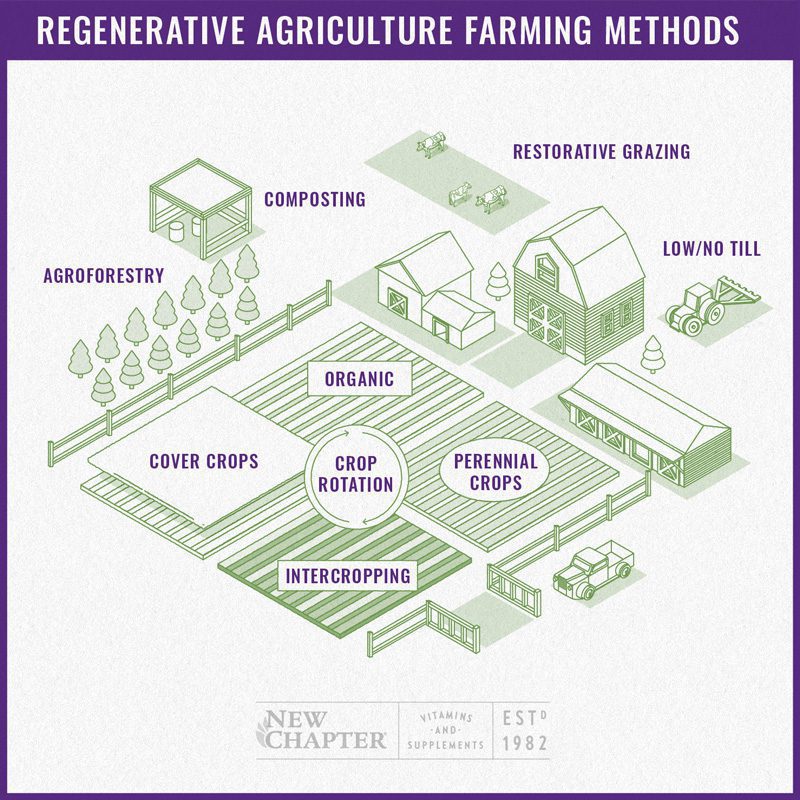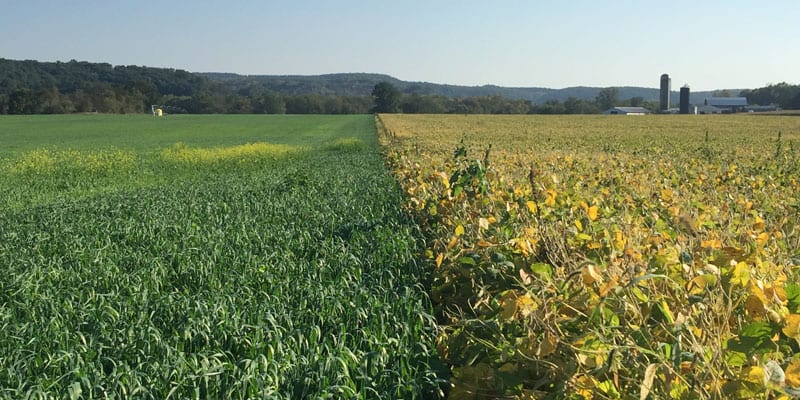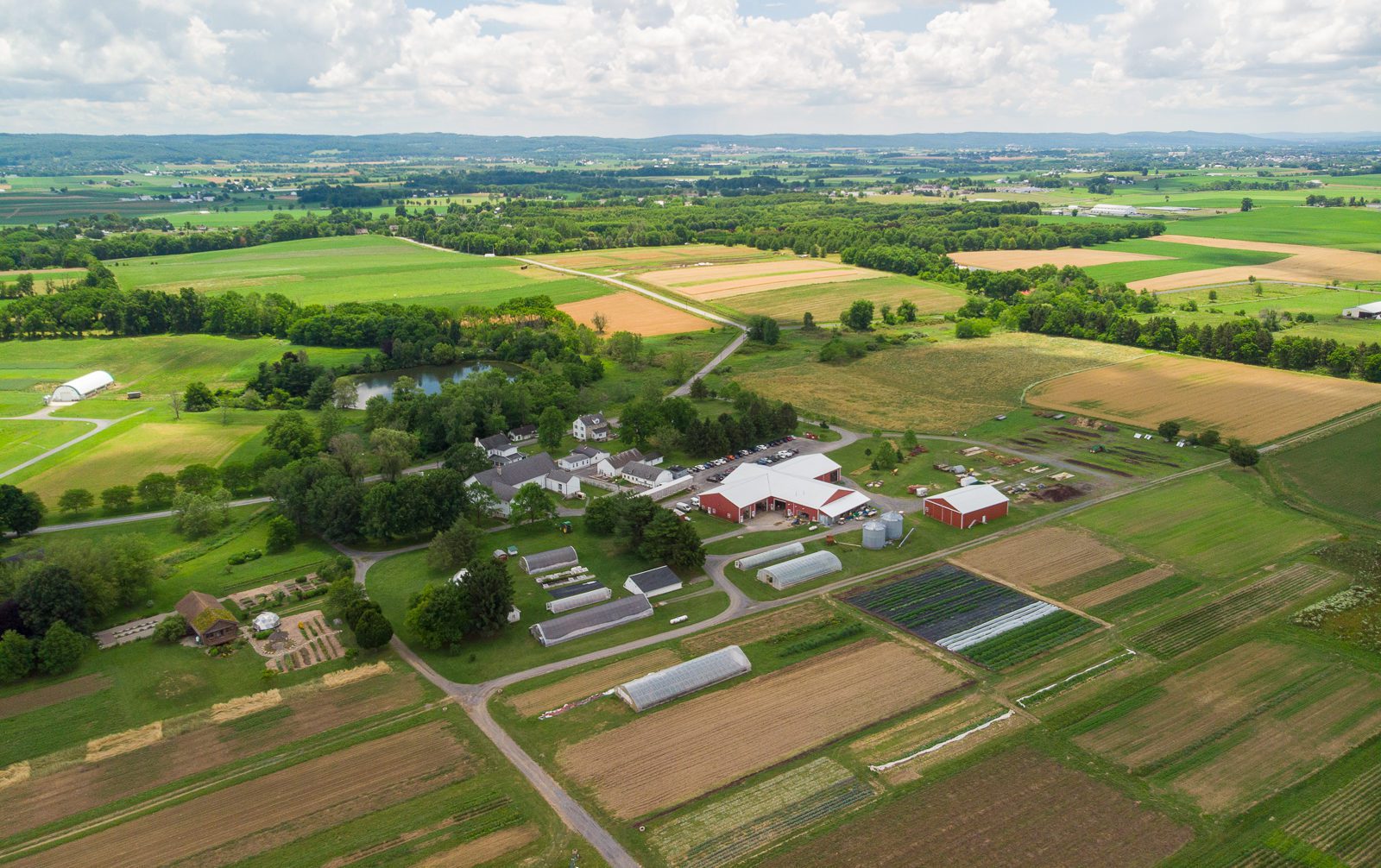Regenerative agriculture is a nature-friendly conservation and rehabilitation approach to food and farming systems. It is not a specific practice, but instead a combination of sustainable agriculture techniques that sequester carbon in the soil while improving soil health, crop yields, water resilience, and nutrient density. To put it simply, regenerative agriculture mimics how nature and farming would work without human interaction.
What are some regenerative agriculture practices and techniques?
One example of regenerative agriculture is farming and grazing practices that restore degraded soil such as eliminating tilling and moving away from synthetic fertilizers, pesticides, and herbicides. Tilling breaks up soil aggregation and fungal communities while adding more carbon to the soil. It also greatly increases soil erosion.
Another technique is improving plant diversity through intercropping cash crops. This is done by growing two or more crops close to each other, employing crop rotations, and/or planting multiple different species together as a cover crop. This biodiversity amongst plants helps supply plants with the nutrients they need and greatly reduces or eliminates the need for synthetic fertilizers. This biodiversity with the lack of chemicals also helps pollinators such as bees pollinate.
Additionally, the regenerative agriculture technique of applying compost as a cover crop to the soil increases carbon capture in the soil. The cover crops protect the soil, prevent erosion, and build more organic matter back into the soil; all of which draw more carbon out of the atmosphere. In fact, shifting both crop and pasture management globally to regenerative systems can reduce over 100% of annual CO2 emissions.

What are the benefits of regenerative agriculture?
The benefits of regenerative agriculture are threefold. There are benefits to the consumers, farmers, and planet. First of all, it benefits the consumers because it makes the food we eat healthier.
Over the past 50 years, the food we eat has decreased greatly in nutritional value. Research shows that you have to eat 8 of the oranges grown in 2021 to get the same nutrients as you would from 1 orange in the 1970s. This is a consequence of our lessened soil quality. Traditional practices like tillage and the use of herbicides, fungicides, and fertilizers decrease nutrient levels. Since regenerative agriculture reduces disturbance and nurtures the soil biology, supporting the life of the soil and reducing soil erosion, the crops have more nutrients.
Regenerative agriculture also benefits the farmers who take part in the practice. Even though it produces lower yields, a recent study found that farms using regenerative practices were 78 percent more profitable than those using only conventional practices. One reason for this is saving money from the reduced use of chemicals like fertilizers, herbicides and pesticides, and antibiotics. Additionally, consumers increasingly want their food to be sourced from farms that take part in regenerative farming, growing the market.
Lastly, regenerative agriculture helps the planet. The lessened chemical and pesticide inputs on regenerative farms mean that fewer chemicals pollute the ground and surface water. This also leads to increased resilience to floods and droughts. Regenerative agriculture also encourages plant photosynthesis which reduces the amount of CO2 in the atmosphere.


Photo Credit: Kiss the Ground
What is the difference between regenerative agriculture and organic?
Organic is a labeling term that denotes products produced under the authority of the Organic Foods Production Act that sets strict standards overseen by the federal government. In order for products to be considered organic, they must have been produced following all organic regulations. For example, organic farmers cannot use genetically engineered seeds or most synthetic fertilizers or pesticides.
While organic production has the intention to promote ecological balance and conserve biological diversity, it does not try to rebuild or regenerate the soil. Regenerative agriculture goes a step further to incorporate management principles focused on the soil and the health of the land, which includes the soil, water, plants, animals, and humans.
When and where did regenerative agriculture start?
The Rodale Institute is the birthplace of regenerative agriculture. Robert Rodale coined the term in the early 1980s to distinguish a kind of farming that goes beyond sustainable. The institute formed the Regenerative Agriculture Association which began publishing books about the topic in 1987. Today, the nonprofit institute continues to grow the movement through research, farmer training, and consumer education.
Even though the term has existed for decades, it has increasingly appeared in the past two decades in academic research papers, books, and TED talks. In the last few years, several large corporations have announced regenerative agriculture initiatives.

Photo Credit: Rodale Institute
What companies take part in regenerative agriculture?
In 2019, General Mills announced that it would begin sourcing a portion of its corn, wheat, dairy, and sugar from farmers who take part in regenerative agriculture. The company committed to advancing this practice on one million acres of land by 2030. Additionally, in 2020, Whole Foods announced that regenerative agriculture would be the top food trend; business interest in the field subsequently spiked by 138%.
More recently, PepsiCo announced it was adopting regenerative agriculture practices on 7 million acres of farmland, Cargill committed to 10 million acres by 2030, and Walmart has pledged to 50 million acres by 2030. These promises are a big deal—there are currently only 5 million acres of farmland dedicated to organic farming practices in the country.
In addition to food companies, vitamin company New Chapter sources its ingredients from regenerative agriculture farms to ensure that the ingredients they implement into their fermented supplements and multivitamins are as nutritious as possible. New Chapter is also a philanthropic partner of the Rodale Institute, funding things like vegetable system trials to further the research and development of regenerative agriculture.
Discover more about innovations in agriculture and nutrition on Tomorrow’s World Today’s presentation of “The Science Behind Supplements” streaming NOW on Science Channel GO and Discovery GO!




